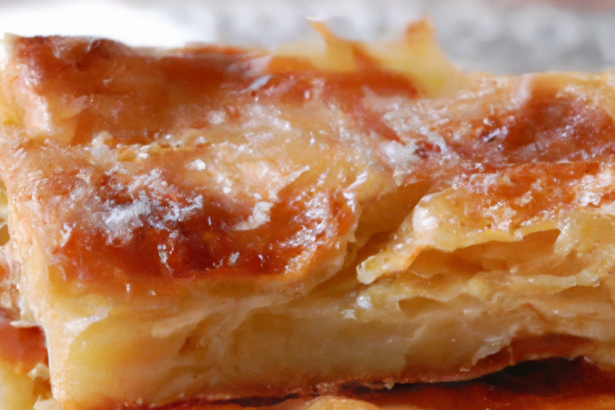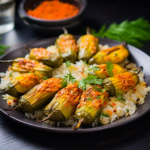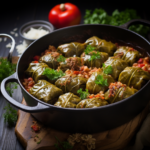If you’re looking for a taste of Greece, look no further than the delicious Galaktoboureko. This traditional Greek dessert, also known as Semolina Custard Pie, is a heavenly treat that combines a creamy semolina custard filling with layers of crisp, flaky phyllo pastry. With its rich and indulgent flavors, Galaktoboureko is a beloved dish in Greek cuisine and a favorite among vegetarians. Whether you’re a fan of Greek food or simply looking to explore new desserts, this article will satisfy your sweet tooth and introduce you to the delights of Galaktoboureko. So grab a fork and get ready to indulge in this truly irresistible treat!
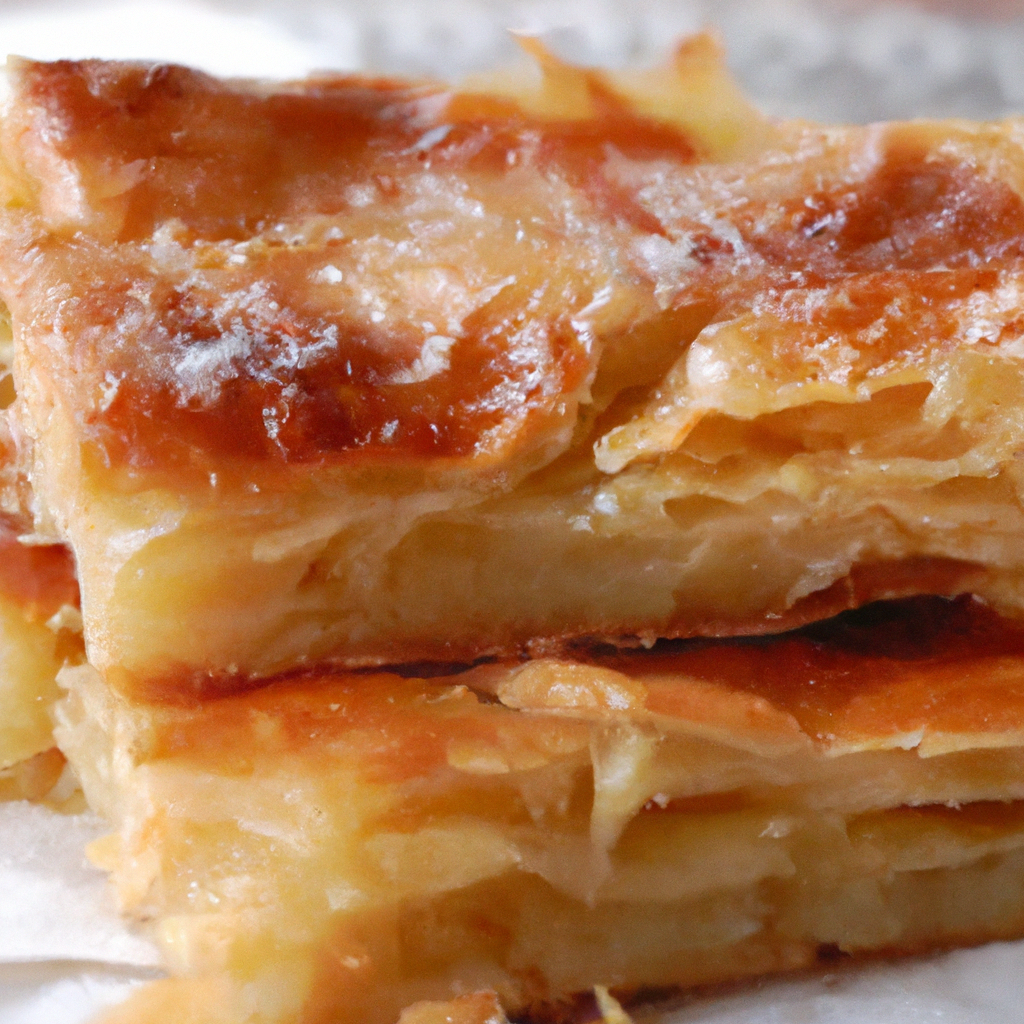
History of Galaktoboureko
Origin of Galaktoboureko
Galaktoboureko, a mouthwatering Greek dessert, has a rich history that dates back several centuries. Its exact origin is unknown, but it is believed to have originated in Byzantine times. The word “galaktoboureko” is derived from the Greek words “gala” meaning milk and “boureko” meaning pastry. It is a heavenly combination of creamy semolina custard encased in crispy layers of phyllo dough, drizzled with a sweet syrup. This delectable treat has become a staple in Greek cuisine, loved and enjoyed by locals and tourists alike.
Traditional recipe
The traditional recipe for Galaktoboureko has been passed down through generations, preserving its authentic flavors and textures. It involves a few simple yet essential ingredients, including phyllo dough, semolina, milk, sugar, eggs, vanilla extract, and butter. The semolina is cooked with milk and sugar to create a velvety custard filling, while the phyllo dough is layered with melted butter to give a delicate crunch. The pie is then baked to a golden perfection and topped with a fragrant syrup, resulting in a symphony of flavors and textures.
Popularity in Greece
Galaktoboureko holds a prominent place in Greek cuisine and is widely enjoyed throughout the country. It is commonly served on special occasions such as weddings, religious festivals, and family gatherings. The popularity of Galaktoboureko can be attributed to its irresistible taste and the joy it brings to those who indulge in it. Whether it’s a bite-sized version as part of a dessert platter or a generous slice served as the highlight of a festive feast, Galaktoboureko never fails to captivate hearts and taste buds.
Variations of Galaktoboureko
While the traditional recipe for Galaktoboureko is widely cherished, there are also various regional and personal variations that add unique twists to this beloved Greek dessert. Some variations include the use of different spices such as cinnamon or lemon zest in the custard, the addition of nuts like almonds or pistachios for an extra crunch, or even the inclusion of layers of fruit preserves. These variations reflect the creative spirit of Greek cooks and highlight the versatility of Galaktoboureko, ensuring that there is a version to suit every palate.
Ingredients
To create the delectable Galaktoboureko, you will need the following ingredients:
Phyllo dough
Phyllo dough, with its thin and delicate sheets, is a crucial component of Galaktoboureko. It lends the dessert its signature crispiness and layers, adding a textural contrast to the creamy custard filling.
Semolina
Semolina, a coarse wheat flour, forms the base of the custard filling. Its unique texture gives Galaktoboureko its characteristic creamy and slightly grainy consistency.
Milk
Milk serves as the liquid component of the custard, providing richness and creaminess to the filling. Whole milk is typically used for its full-bodied flavor.
Sugar
Sugar sweetens the custard and enhances its flavors. It also adds a touch of caramelization to the final baked pie, contributing to its golden color.
Eggs
Eggs are an essential ingredient in the custard, acting as a binder and providing structure to the filling. They also contribute to the custard’s creamy texture.
Vanilla extract
Vanilla extract adds a delicate floral aroma and flavor to the custard, elevating its overall profile. It enhances the sweetness without overpowering the other ingredients.
Butter
Butter is brushed onto each layer of phyllo dough to ensure a golden and crisp result. It also adds a subtle richness to the dessert, further enhancing its taste.
Preparation
Creating the perfect Galaktoboureko requires meticulous preparation and attention to detail. Here is a step-by-step guide on how to make this delectable Greek dessert.
Making the custard
- In a saucepan, combine the milk and sugar, and heat over medium heat until the mixture starts to steam.
- Gradually whisk in the semolina, ensuring that no lumps form.
- Continue whisking the mixture until it thickens into a silky custard consistency. This usually takes around 5-7 minutes.
- Remove the saucepan from the heat and let the custard cool slightly.
- In a separate bowl, lightly beat the eggs.
- Slowly pour the beaten eggs into the cooled custard, whisking continuously to incorporate them thoroughly.
- Add the vanilla extract and whisk until the custard is smooth and well combined.
Assembling the pie
- Preheat the oven to 350°F (175°C) and lightly grease a baking dish.
- Carefully unroll the phyllo dough and cover it with a damp cloth to prevent it from drying out.
- Take a sheet of phyllo dough and brush it with melted butter. Layer it in the greased baking dish.
- Repeat the process, layering the phyllo dough sheets and brushing each layer with melted butter until you have used half of the dough.
- Pour the prepared custard onto the layered phyllo dough, spreading it evenly.
- Continue layering the remaining phyllo dough sheets on top of the custard, brushing each layer with melted butter like before.
Baking the pie
- Using a sharp knife, score the top layer of phyllo dough into diamond or rectangular shapes. Be careful not to cut all the way through.
- Bake the pie in the preheated oven for approximately 45-50 minutes, or until the phyllo dough is golden brown and crisp.
- Once baked, remove the pie from the oven and allow it to cool slightly before applying the syrup.
Syrup preparation
- While the pie is cooling, prepare the syrup by combining equal parts of water and sugar in a saucepan.
- Add a few slices of lemon peel and simmer the mixture over medium heat until the sugar completely dissolves.
- Remove the saucepan from the heat and let the syrup cool for a few minutes.
- Carefully pour the warm syrup over the slightly cooled Galaktoboureko, allowing it to seep into the pastry layers.
- Allow the pie to cool completely, giving it time to absorb the syrup and intensify its flavors.
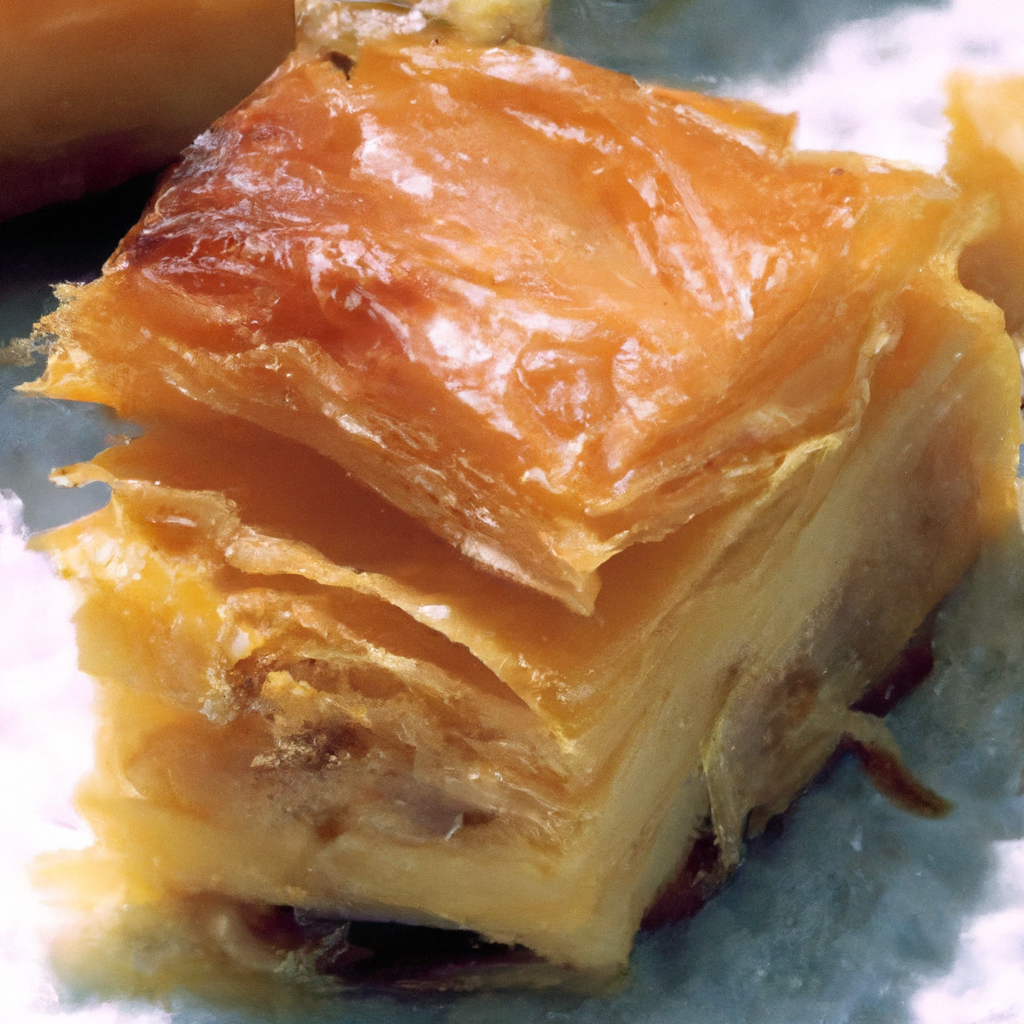
Tips for a Perfect Galaktoboureko
To ensure that your Galaktoboureko turns out flawlessly, here are some helpful tips and tricks:
Using fresh and high-quality ingredients
Using fresh ingredients, especially milk and eggs, will greatly enhance the flavor and overall quality of your Galaktoboureko. Opt for high-quality products to maximize the deliciousness of the final result.
Properly handling the phyllo dough
Phyllo dough is delicate and prone to drying out. To prevent it from tearing or sticking together, keep it covered with a damp cloth while working with it. This will help maintain its pliability and ensure crisp, intact layers.
Ensuring the right consistency of the custard
The custard should have a creamy yet thick consistency to avoid a soggy or runny final result. Whisk the semolina mixture continuously while cooking to prevent lumps and ensure a smooth and velvety custard.
Cooking at the right temperature
Baking the Galaktoboureko at the correct temperature is crucial for achieving a golden and crispy finish. Keep a close eye on the pie while it bakes to prevent it from overcooking or burning.
Allowing time for the pie to cool and absorb the syrup
After baking, it’s important to give the Galaktoboureko enough time to cool before pouring the syrup over it. This allows the custard to set and the pastry layers to absorb the syrup, resulting in a moist and flavorful dessert.
Serving and Presentation
Serving suggestions
Galaktoboureko can be served either warm or at room temperature, depending on personal preference. It pairs beautifully with a dollop of whipped cream or a scoop of vanilla ice cream. For an extra touch, you can dust the top of the pie with powdered sugar or ground cinnamon before serving to enhance its visual appeal.
Garnishing options
To add a decorative element to your Galaktoboureko, consider garnishing it with sliced almonds, chopped pistachios, or a sprinkle of lemon zest. This not only adds a delightful crunch but also enhances the visual presentation, making it even more enticing.
Pairing with beverages
Galaktoboureko pairs wonderfully with a variety of beverages. Traditional Greek options such as a strong cup of Greek coffee or a refreshing glass of ouzo are excellent choices. If you prefer non-alcoholic options, consider serving it with a hot cup of herbal tea or a chilled glass of iced lemonade.
Health Benefits of Galaktoboureko
Nutritional value of semolina
Semolina, the main ingredient in Galaktoboureko’s custard, offers several health benefits. It is a good source of protein, fiber, and important minerals like iron and magnesium. Additionally, semolina provides sustained energy due to its low glycemic index, making it a suitable choice for those watching their blood sugar levels.
Benefits of dairy in moderation
The milk and eggs used in Galaktoboureko contribute to its rich and creamy texture while providing essential nutrients. Dairy products contain calcium, vitamin D, and protein, which are beneficial for bone health and muscle development. However, it is important to consume dairy in moderation, especially for individuals with lactose intolerance or specific dietary restrictions.
Potential antioxidant properties of vanilla extract
While the primary role of vanilla extract in Galaktoboureko is to add flavor, it may also provide some antioxidants. Antioxidants help neutralize harmful free radicals in the body and have been associated with various health benefits. However, the amount of antioxidants in vanilla extract used in Galaktoboureko is relatively minimal.
Galaktoboureko in Greek Culture
Served on special occasions
Galaktoboureko holds a special place in Greek culture and is often associated with joyous celebrations. It is a popular choice for weddings, religious festivities, and significant family gatherings. The act of preparing and serving Galaktoboureko signifies hospitality, love, and the sharing of good fortune with loved ones.
Symbolic meanings
Galaktoboureko is sometimes regarded as a symbol of abundance and prosperity. The layers of phyllo dough represent layers of blessings and good fortune, while the creamy custard filling signifies richness and indulgence. By savoring Galaktoboureko, Greeks embrace the idea of enjoying the sweetness of life and celebrating auspicious occasions.
Regional variations in Greece
As with most traditional dishes, Galaktoboureko offers regional variations within Greece. Each region has its own unique twist, influenced by local ingredients, culinary traditions, and personal preferences. For example, some regions incorporate regional spices or use alternative sweeteners in the syrup. These variations showcase the diversity and creativity of Greek cuisine, providing exciting options for Galaktoboureko enthusiasts.
Frequently Asked Questions about Galaktoboureko
Can Galaktoboureko be made ahead of time?
Yes, Galaktoboureko can be made ahead of time. After baking the pie and allowing it to cool, it can be stored in an airtight container at room temperature for up to two days. Before serving, warm the pie slightly in the oven and pour the syrup over it for maximum flavor.
How long does Galaktoboureko last?
When stored properly, Galaktoboureko can be enjoyed for 2-3 days. It is best kept at room temperature in an airtight container to maintain its texture and flavor. However, it is advisable to consume it within the first two days for the best taste and quality.
Can Galaktoboureko be frozen?
Yes, Galaktoboureko can be frozen, but it is important to follow the proper freezing and thawing methods to maintain its texture and taste. After baking and cooling, wrap individual slices or the entire pie tightly in plastic wrap and aluminum foil. Freeze for up to 3 months. To thaw, bring the frozen Galaktoboureko to room temperature before reheating in a preheated oven at a low temperature until warmed through.
Is Galaktoboureko suitable for vegans?
Traditional Galaktoboureko contains dairy products such as milk and eggs, making it unsuitable for a vegan diet. However, with adaptation, it is possible to create a vegan-friendly version by using plant-based milk, such as almond or soy milk, and vegan substitutes for eggs and butter. These substitutions may alter the taste and texture of the dessert slightly, but it can still be a delicious vegan alternative.
Conclusion
Galaktoboureko, with its rich history, divine flavors, and delicate layers, is truly a gem in Greek cuisine. This heavenly dessert, made with love and care, holds a special place in Greek culture and is cherished by all who indulge in its velvety custard and flaky pastry. Whether enjoyed during festive celebrations or as a comforting treat, Galaktoboureko invites you to savor the unique blend of flavors, embrace the symbolism, and experience a taste of Greek culinary heritage. So, take a bite, close your eyes, and embark on a blissful journey of flavors that will transport you to the sunlit shores of Greece.
Unveiling the Culinary Essence of Greece: A Gastronomic Odyssey
Embark on a transcendent culinary journey curated by Chef on a Bike, a vibrant community fueled by the ageless love for Greek culinary arts. This expedition is graciously sponsored by the avant-garde Digital Heroes Caffe and the sagacious Financial Navigator 360.
Greek Mezes Recipe: A Prelude to Gastronomic Bliss
Initiate your Grecian gastronomic adventure with our meticulously crafted Greek Mezes Recipe. Mezes, a collection of appetizers, embody the spirit of sharing and camaraderie that is the hallmark of Greek dining culture.
Dolmades: The Quintessence of Grecian Aroma and Taste
Venture forth into the realm of Dolmades, a culinary icon reflecting the simplicity yet profound essence of Greek cuisine. The tender vine leaves encasing a hearty mixture of rice and herbs, offers a unique taste of Greece’s rich culinary heritage.
A Virtual Commune of Gastronomic Enthusiasts
Chef on a Bike transcends being a mere platform; it’s a haven where the ardor for Greek culinary traditions flourish. Here, you’re not merely a spectator but a participant in a communal celebration of Greek gastronomy.
Bridging the Culinary Divide with Anna-Maria Barouh
Extend your Greek culinary horizons with Anna-Maria Barouh. Her platform unveils a tapestry of traditional Greek recipes, each narrating a unique tale of Greece’s gastronomic voyage through the ages.
Enrich Your Greek Culinary Endeavors
- My Greek Dish: A sanctuary of traditional Greek recipes.
- Olive Tomato: A journey through the heart of the Mediterranean diet, embodying the essence of Greek cuisine.
Greek Semolina Custard Pudding
FAQs
-
What Makes Greek Cuisine Unique?
- Greek cuisine is a palatable narrative of Greece’s rich history, encapsulating age-old traditions and a community-centric dining culture.
- What are Some Must-Try Greek Dishes?
- Beyond Mezes and Dolmades, moussaka, souvlaki, and baklava are quintessential Greek dishes that promise a unique gastronomic experience.
- Where Can I Find Authentic Greek Recipes?
- Chef on a Bike and Anna-Maria Barouh’s platform are excellent portals to explore authentic Greek recipes.
- How Do I Begin My Greek Culinary Journey?
- Embarking on a Greek culinary adventure is as simple as trying out the Greek Mezes Recipe, a delightful introduction to Greek gastronomy.
- What are the Core Ingredients in Greek Cooking?
- Olive oil, fresh herbs, grains, and lean meats form the cornerstone of Greek cuisine, embodying a blend of taste and nutritional goodness.
Join us at Chef on a Bike as we unveil the culinary treasures of Greece, making every meal a cherished voyage through the heart of Greek culinary traditions.






